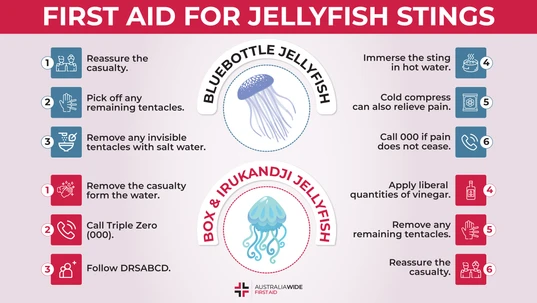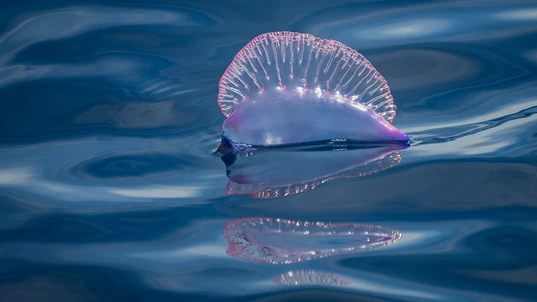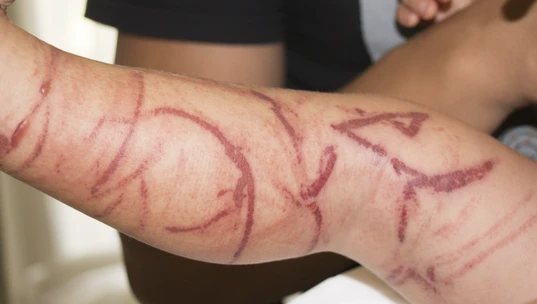First Aid for Jellyfish Stings

Bites and Stings

Australia is home to a variety of jellyfish, aquatic animals that can sting humans and cause severe, sometimes fatal symptoms. Knowing how to treat different jellyfish stings could one day save your life.
Jellyfish are found in every ocean, from the surface to the deep sea. They come in a variety of shapes and sizes and their venom can vary from species to species. A jellyfish sting can be painful and cause swelling, redness and itching. In some cases, it can also lead to more serious reactions such as anaphylaxis. In Australia, there are a number of dangerous jellyfish species including the Irukandji, bluebottle and box jellyfish. If you are stung by a jellyfish, it is important to seek medical attention as soon as possible.Types of jellyfish
There are two main types of jellyfish; true jellyfish and hydrozoans. True jellyfish are classified under the phylum Cnidaria, while hydrozoans are classified under the phylum Hydrozoa. Hydrozoans are a group of aquatic animals that includes hydroids, Portuguese man-of-wars and jellyfish. These animals have stinging cells on their tentacles, which they use to capture prey and defend themselves from predators. Hydrozoans can be either solitary or colonial. Some Hydrozoa include:- Hydroids
- Portuguese man-of-wars
- Jellyfish
- Australian box jellyfish
- Bluebottle
- Irukandji

Interestingly, Bluebottle jellyfish are not a single animal. Rather, they are a colony of 'zooids' that grow through repeated rounds of asexual reproduction. Bluebottles are commonly sighted along Sydney beaches in summer.
Bluebottle
The bluebottle is a blue or purple jelly-like creature with a translucent body and long tentacles. The tentacles can be up to 3 metres long. When there are storms, you can often find bluebottles washed up along the shore.Locations
The bluebottle is mostly found along the eastern coasts of Australia, from northern Queensland to southern New South Wales. It is mostly found in open ocean waters, though they often wash up on shore during summer.Symptoms
The symptoms of a bluebottle sting include:- 'Trails' of blue 'tentacles' adhering to the body or limbs
- Stinging sensation associated with the contact
- Reddening of the skin
- Pain for some hours
First aid and ongoing treatment
If you are stung by a bluebottle, it is important to remain calm and remove the tentacles as soon as possible. You can do this by using a stick or your fingers to gently brush them off. If you use your fingers, you could risk transferring the stinging cells to your hands, so an inanimate object is recommended. Once the tentacles have been removed, rinse the affected area with seawater to remove any remaining stinging cells. Then, immerse the affected area in hot water, or cover it with hot running water (as in a shower), for at least 20 minutes. Make sure that the water will not scald the casualty. If hot water is not available, a cold compress may be able to provide some relief. Vinegar is not effective with bluebottle stings. In fact, it can actually make the pain worse. You should call Triple Zero (000) for an ambulance if the pain is generalised, persistent, or does not cease; if the stung area is larger than half a limb; or, it involves a sensitive area of the body, such as the eyes. You should also call Triple Zero (000) for an ambulance if you feel faint, dizzy, or have difficulty breathing, as this could be a sign of an allergic reaction. It is important to remember, in the case of all jellyfish stings, you should seek assistance from a lifeguard if one is nearby and available. In the days following the sting, you can take over-the-counter pain medication, such as ibuprofen or paracetamol, to help relieve pain and swelling. Please make sure to follow the packet instructions.Complications
In some cases, a bluebottle sting can lead to more serious complications such as:- Anaphylaxis
- Cardiac arrest
- Neurological damage
- Kidney failure
Prognosis
Most people will recover from a bluebottle sting without any long-term effects. However, in some cases, the symptoms can last for several days or weeks. If you experience any severe or persistent symptoms, it is important to seek medical attention as soon as possible.
Box jellyfish are so named because of their box-shaped bell, or body. In Australia, they are commonly found in tropical coastal waters spanning from Western Australia to the Northern Territory and Queensland.
Australian box jellyfish
The box jellyfish is a uniquely cube-shaped jellyfish with short tentacles. It is transparent and can grow up to 25 cm long in its body, but its tentacles can be up to 3 metres in length. Box jellyfish generally have between 40 - 60 tentacles, each of which comprise 3000 to 5000 stinging cells. As such, it’s not uncommon to be stung in multiple places. These tentacles have cells called nematocysts which contain a strong venom that targets red blood cells and the heart. The box jellyfish is one of the most venomous animals in the world and has enough toxin to kill an adult human within 5 minutes! Thankfully, stings from this jellyfish are rare due to the preventative measures in place, including stinger suits and nets during the jellyfish breeding season.Locations
Box jellyfish are found in tropical waters around Australia, Indonesia and the Philippines. They are often found in shallow coastal waters, such as estuaries, bays and harbours. Their breeding season is from October to March. During these times, stinger nets are often put in place at popular swimming beaches to protect swimmers.Symptoms
The symptoms of a box jellyfish sting include:- Intense pain - so intense that it may cause irrational behaviour
- Frosted pattern of sting marks
- Welt marks from tentacles
- Tentacles left on skin
- Cardiac arrest
- Collapse leading to unconsciousness and death
- Difficulty breathing
First aid
If you are stung by a box jellyfish, follow the below instructions:- It is important to get the person out of the water as soon as possible.
- Call Triple Zero (000) for an ambulance and alert lifesavers urgently.
- Assess the person, follow DRSABCD and be prepared to perform CPR.
- Apply as much vinegar as possible to the affected area for at least 30 seconds. This prevents the stinging cells from releasing venom into the skin. Most tropical Australian beaches have vinegar along the beach in case of jellyfish stings.
- If vinegar is not available, carefully remove the tentacles with a stick or other inanimate object and rinse the affected area well with seawater. However, do not compress the affected area or rinse it with fresh water, as this will stimulate the stinging cells and cause them to release more venom.
- Do not rub the affected area, as this will also stimulate the stinging cells and cause them to release more venom.
- Calm and reassure the casualty and do not allow them to move or over-exert themselves, as this can move the venom quickly through the body and cause more serious complications.
- While waiting for the ambulance, you can apply a cold compress to the affected area to relieve pain. You can also manage the pain by soaking the affected area in hot water.
Complications
In some cases, the person may experience an allergic reaction to the sting. Symptoms of an allergic reaction include:- Difficulty breathing
- Swelling of the face, lips or tongue
- Hives
- Dizziness
Prognosis
A severe sting, which is characterised as a person being stung on more than 10% of their body, can result in death via cardiac arrest. This has most often occurred when children are stung by an adult box jellyfish. A sting on less than 10% of the body is considered moderate and will result in severe pain for several hours. The person may also experience nausea, vomiting and sweating. Likewise, in some cases, a person may be left with scars.Ongoing treatment
Treatment for a box jellyfish sting must be administered by an emergency health team or hospital. Treatments may include pain medication, anti-venom, as well as managing breathing or cardiac complications resulting from the sting.Looking to get you First Aid knowledge up to date?
We run certified First Aid courses throughout all major Acustralian citys. Find a location near you.

Irukandji jellyfish are one of the smallest jellyfish in the world, and generally only grow 1 to 2 cm in diameter. Unlike many other jellyfish, Irukandji do NOT leave welt marks (like the ones shown above) when they sting people.
Irukandji
Irukandji are a group of small, extremely venomous jellyfish found in the waters off northern Australia. The Irukanji are tiny and generally grow to the size of a 10c coin, while their 4 tentacles are typically 10cm in length. Despite their small size, they pack a powerful sting that can cause severe symptoms. Irukandji are one of the most venomous jellyfish in the world and can cause death in humans. The sting from an Irukandji can cause an extreme reaction known as Irukandji syndrome.Locations
Irukandji are found in warm, tropical waters off the coast of northern Australia, from northern Queensland to northern Western Australia. They are most commonly found during their breeding season, which is between October and February. An Irukandji will live in the deep waters off the coast and only come into shallower waters to breed.Symptoms
Symptoms of Irukandji syndrome usually appear about 30 minutes after the person has been stung. In saying that, symptoms can appear in as little as 5 minutes or as long as 45 minutes after the sting has occurred. The first symptoms are often a feeling of anxiety or unease, followed by a sense of foreboding or doom. Severe symptoms will then follow and usually include:- Intense muscle pain, typically in the form of a headache or backache
- Shooting chest, abdominal and muscle pain
- Anxiety
- Restlessness
- Breathing difficulties
- Nausea and vomiting
- Increased heart rate and blood pressure
- Sweating
- Fever
- Dizziness
First aid
If you are stung by an Irukandji, follow the below instructions:- It is important to get the person out of the water as soon as possible.
- Call Triple Zero (000) for an ambulance and alert lifesavers urgently.
- Assess the person, follow DRSABCD and be prepared to perform CPR.
- Apply as much vinegar as possible to the affected area for at least 30 seconds. This prevents the stinging cells from releasing venom into the skin. Most tropical Australian beaches have vinegar along the beach in case of jellyfish stings.
- If vinegar is not available, carefully remove the tentacles with a stick or other inanimate object and rinse the affected area well with seawater. However, do not compress the affected area or rinse it with fresh water, as this will stimulate the stinging cells and cause them to release more venom. Likewise, keep in mind that the tentacles of the Irukandji are translucent and may be difficult to see.
- Do not rub the affected area, as this will also stimulate the stinging cells and cause them to release more venom.
- Calm and reassure the casualty and do not allow them to move or over-exert themselves, as this can move the venom quickly through the body and cause more serious complications.
- While waiting for the ambulance, you can apply a cold compress to the affected area to relieve pain. You can also manage the pain by soaking the affected area in hot water.
Complications and Prognosis
Irukandji syndrome is a rare and potentially fatal condition caused by the sting of an Irukandji jellyfish. As it can cause pulmonary oedema, hypertensive stroke and heart failure, it is possible to have ongoing cardiovascular complications as a result of an Irukandji sting.Prevention
The best way to prevent being stung by an Irukandji is to avoid swimming in waters where they are found. If you do find yourself in these waters, it is important to wear a full-body stinger suit. This will protect you from being stung by an Irukandji jellyfish.Ongoing treatment
If you are stung by an Irukandji jellyfish, it is important to seek emergency medical attention immediately. There is no specific antidote for the venom and treatment focuses on relieving symptoms and supporting the cardiovascular system. Intravenous fluids are often given to help maintain blood pressure and support the cardiovascular system. Pain relief medication, such as opioids, may also be given to help relieve the intense muscle pain caused by the sting. In some cases, it may be necessary to provide respiratory support or intensive care if the person experiences pulmonary oedema or cardiac failure.Final thoughts
Jellyfish stings can be a painful experience. In some cases, they can also be fatal. In this article, we have outlined the first aid measures that should be taken if you are stung by a jellyfish while swimming in Australia. You should always be aware of the dangers when swimming in tropical waters and try to protect yourself by wearing a full-body stinger suit or swimming within designated stinger nets. If you are stung, it is important to seek medical attention immediately and attend to the sting using first aid training. We offer first aid courses that can provide you with the skills and knowledge to effectively treat a sting from a jellyfish or any other type of marine life. Visit our website to find out more or contact us to book a course today.
Originally published at
https://www.australiawidefirstaid.com.au/resources/first-aid-for-jellyfish-stings
as part of the Australia Wide First Aid Articles Library









